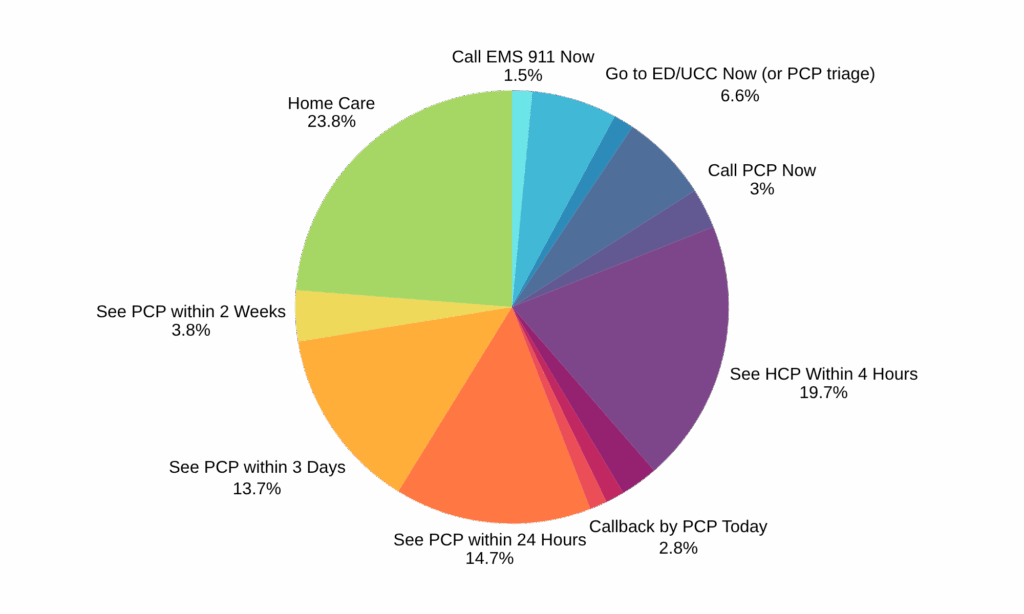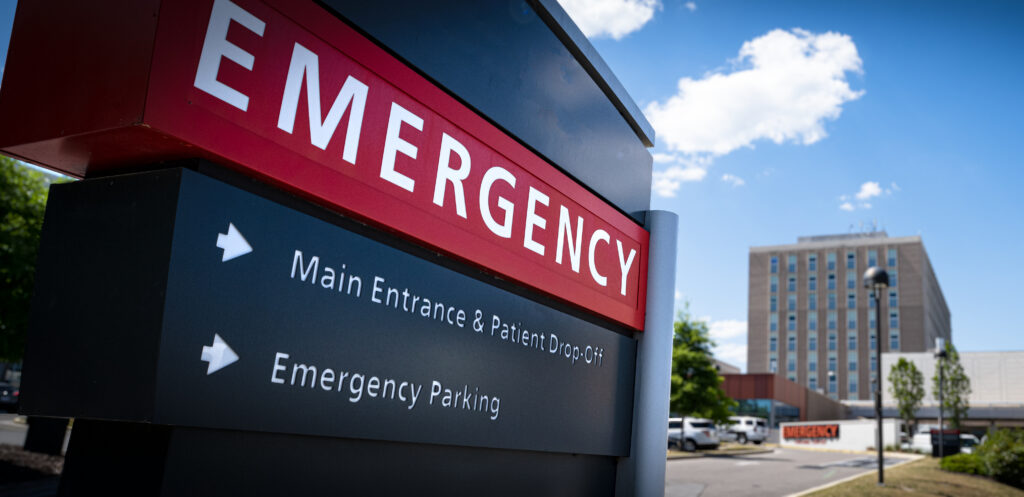The Schmitt-Thompson nurse telehealth protocols used in ClearTriage are designed to help reduce unnecessary use of high-cost resources like 911 and the ED. But what does that look like in practice?
To get a better understanding, we analyzed anonymized data for approximately 3.5 million calls taken using ClearTriage in 2025. While this isn’t a formal scientific study, we approached the analysis carefully and we hope you find the results both interesting and useful.
Sections
Overall Disposition Usage
After Hours vs Office Hours
Adult vs. Peds
Single Content Set vs. Both
Overall Disposition Usage
Let’s start by examining the dispositions for all 3.5 million calls – Adult and Pediatric, After Hours and Office Hours. To do this, we combined similar After Hours and Office Hours dispositions. We also removed less commonly used dispositions because they made it hard to see the overall patterns. With those considerations in mind, this view offers a valuable snapshot of how telephone triage helps guide overall resource utilization.
| Disposition | Percent Used |
|---|---|
| Call EMS 911 Now | 1.5% |
| Go to ED Now | 6.4% |
| Go to Urgent Care Now | 1.5% |
| Go to ED/UCC Now (or PCP triage) | 6.6% |
| Call PCP Now / Discuss with PCP and Callback by Nurse within 1 Hour | 3.0% |
| See HCP (or PCP Triage) Within 4 Hours / Go to Office Now / See in Office Today | 19.7% |
| Callback by PCP Today / Discuss with PCP and Callback by Nurse Today | 2.8% |
| Call PCP within 24 Hours | 1.4% |
| Call PCP when Office is Open | 1.3% |
| See PCP (or See in Office) within 24 Hours / Today or Tomorrow | 14.7% |
| See PCP (or See in Office) within 3 Days | 13.7% |
| See PCP (or See in Office) within 2 Weeks | 3.8% |
| Home Care | 23.8% |

Observation:
The four most common dispositions are See a Provider Soon (e.g., 4 hours, same day…), See a Provider Within 24 hours (today or tomorrow for Office Hours), See a Provider Within 3 Days, and Home Care.
After Hours vs Office Hours
To begin breaking down the data further, we looked at the differences in disposition usage between users of After Hours and Office Hours protocols. Here’s what we found:
| After Hours (AH) Disposition | AH % | OH % | Office Hours (OH) Disposition |
|---|---|---|---|
| Call EMS 911 Now | 2.4% | 0.8% | Call EMS 911 Now |
| Call PCP Now | 5.6% | 1.1% | Discuss with PCP and Callback by Nurse within 1 Hour |
| Call Poison Center Now | 0.5% | 0.1% | Call Poison Center Now |
| Go to ED Now | 8.9% | 4.5% | Go to ED Now |
| Go to ED/UCC Now (or PCP triage) | 7.7% | 5.7% | Go to ED/UCC Now (or to Office with PCP Approval) |
| Go to Urgent Care Now | 0.6% | 2.1% | Go to Urgent Care Now |
| See HCP (or PCP Triage) Within 4 Hours | 11.2% | 25.3% | Go to Office Now and See in Office Today |
| 4.8% | Callback by PCP Today / Discuss with PCP and Callback by Nurse Today | ||
| Call PCP within 24 Hours | 3.3% | ||
| Call PCP when Office is Open | 3.1% | ||
| See PCP within 24 Hours | 19.9% | 10.9% | See in Office Today or Tomorrow |
| See PCP within 3 Days | 9.9% | 16.1% | See in Office within 3 Days |
| See PCP within 2 Weeks | 2.5% | 4.7% | See in Office within 2 Weeks |
| 0.5% | Strep Test Only Visit Today or Tomorrow | ||
| Home Care | 24.3% | 23.2% | Home Care |
Key Observations:
- Higher acuity dispositions are more common for after hours. This may be because individuals with lower-acuity concerns are more likely to wait until daytime to call. Additionally, at night, the emergency department may be the only available care option for potentially urgent issues.
- “See in Office Now or Today” is used far more often during office hours compared to the similar “See HCP Within 4 Hours” disposition used after hours. This likely reflects the greater availability of primary care visits during the day.
- Dispositions like “See Within 3 Days” and “See Within 2 Weeks” appear more frequently in office hours triage. Again, this may be because patients are more inclined to wait until regular hours to seek help for less urgent concerns.
- Home Care dispositions are used in similar frequencies across both After Hours and Office Hours protocols.
Adults vs. Peds
Next, let’s take a look at how disposition usage differs between Adult and Pediatric protocols, starting with After Hours data:
| After Hours Disposition | Adult Usage | Peds Usage |
|---|---|---|
| Call EMS 911 Now | 3.8% | 0.4% |
| Go to ED Now | 11.3% | 5.2% |
| Go to L&D Now | 0.4% | |
| Call Poison Center Now | 0.3% | 0.7% |
| Go to ED Now (or PCP triage) | 7.7% | 7.5% |
| Go to L&D Now (or PCP triage) | 0.2% | |
| Go to Urgent Care Now | 0.6% | 0.5% |
| See HCP (or PCP Triage) Within 4 Hours | 15.0% | 5.6% |
| Urgent Home Treatment with Follow-Up Call | 0.4% | 0.6% |
| Call PCP Now | 4.1% | 7.5% |
| See PCP within 24 Hours | 19.8% | 19.5% |
| Call PCP within 24 Hours | 3.5% | 3.0% |
| Call Pharmacist within 24 Hours | 0.3% | 0.1% |
| See PCP within 3 Days | 10.4% | 9.0% |
| Call PCP when Office is Open | 3.2% | 2.9% |
| See PCP within 2 Weeks | 3.8% | 0.5% |
| Home Care | 10.9% | 35.5% |
| Home Care – Information or Advice Only Call | 4.1% | 1.3% |
And then Office Hours:
| Office Hours Disposition | Adult Usage | Peds Usage |
|---|---|---|
| Call EMS 911 Now | 1.3% | 0.2% |
| Go to ED Now | 6.7% | 1.8% |
| Go to L&D Now | 0.2% | |
| Go to L&D Now (or to Office with PCP Approval) | 0.1% | |
| Go to ED/UCC Now (or to Office with PCP Approval) | 6.6% | 4.6% |
| Call Poison Center Now | 0.0% | 0.2% |
| Go to Urgent Care Now | 2.7% | 1.3% |
| Go to Office Now | 6.6% | 4.2% |
| Discuss with PCP and Callback by Nurse within 1 Hour | 1.7% | 0.3% |
| See in Office Today | 22.2% | 16.6% |
| See in Office Today or Tomorrow | 12.7% | 8.6% |
| Callback by PCP Today | 1.5% | 0.2% |
| Discuss with PCP and Callback by Nurse Today | 4.9% | 2.5% |
| Strep Test Only Visit Today or Tomorrow | 0.4% | 0.7% |
| See in Office Within 3 Days | 13.5% | 19.2% |
| See in Office Within 2 Weeks | 6.8% | 2.0% |
| Refer to Specialist | 0.4% | 0.1% |
| Home Care | 11.5% | 37.6% |
Key Observations:
- There’s a significant difference in the percentage of calls resulting in a 911 disposition—much higher for adults. Emergency Department referrals are also notably higher for adult callers. This could suggest that adults tend to wait until symptoms become more serious before calling, while parents are more proactive (or cautious) in calling for less severe pediatric concerns.
- Pediatric calls are much more likely to result in a Home Care disposition, indicating that many of these calls can be safely managed at home with guidance from the triage nurse.
Single Content Set vs. Both
For one final comparison, we looked at how disposition usage varies between organizations using only adult or pediatric protocols versus those using both (serving patients across all age groups). Specifically, we focused on two key dispositions: Go to ED Now and Home Care. Here’s what the data reveals:
All 2024 Adult Calls
| Disposition | Protocol Set | Adult Only Users | Adult and Peds Users |
|---|---|---|---|
| Go to ED Now | After Hours Protocols | 8.4 % | 12.5% |
| Office Hours Protocols | 4.4% | 6.9% | |
| Home Care | After Hours Protocols | 14.6% | 14.3% |
| Office Hours Protocols | 14.2% | 10.9% |
All 2024 Pediatric Calls
| Disposition | Protocol Set | Peds Only Users | Adult and Peds Users |
|---|---|---|---|
| Go to ED Now | After Hours Protocols | 3.9% | 5.8% |
| Office Hours Protocols | 1.3% | 2.8% | |
| Home Care | After Hours Protocols | 39.2% | 32.6% |
| Office Hours Protocols | 45.3% | 21.1% |
Key Observations:
Referrals to Go to ED Now are consistently higher among organizations using both adult and pediatric protocols compared to those using just one content set. Conversely, Home Care dispositions are consistently lower for these full age range users.
We’re not entirely sure what’s driving these differences—but the pattern holds across After Hours and Office Hours, and across both Adult and Pediatric protocols. We’ll let you draw your own conclusions (or discuss with a colleague!). Enjoy exploring the data!
ClearTriage is a web-based decision support tool for telephone triage nurses and the leading provider of the Schmitt-Thompson telephone triage protocols. Learn more about the reports available in ClearTriage!

